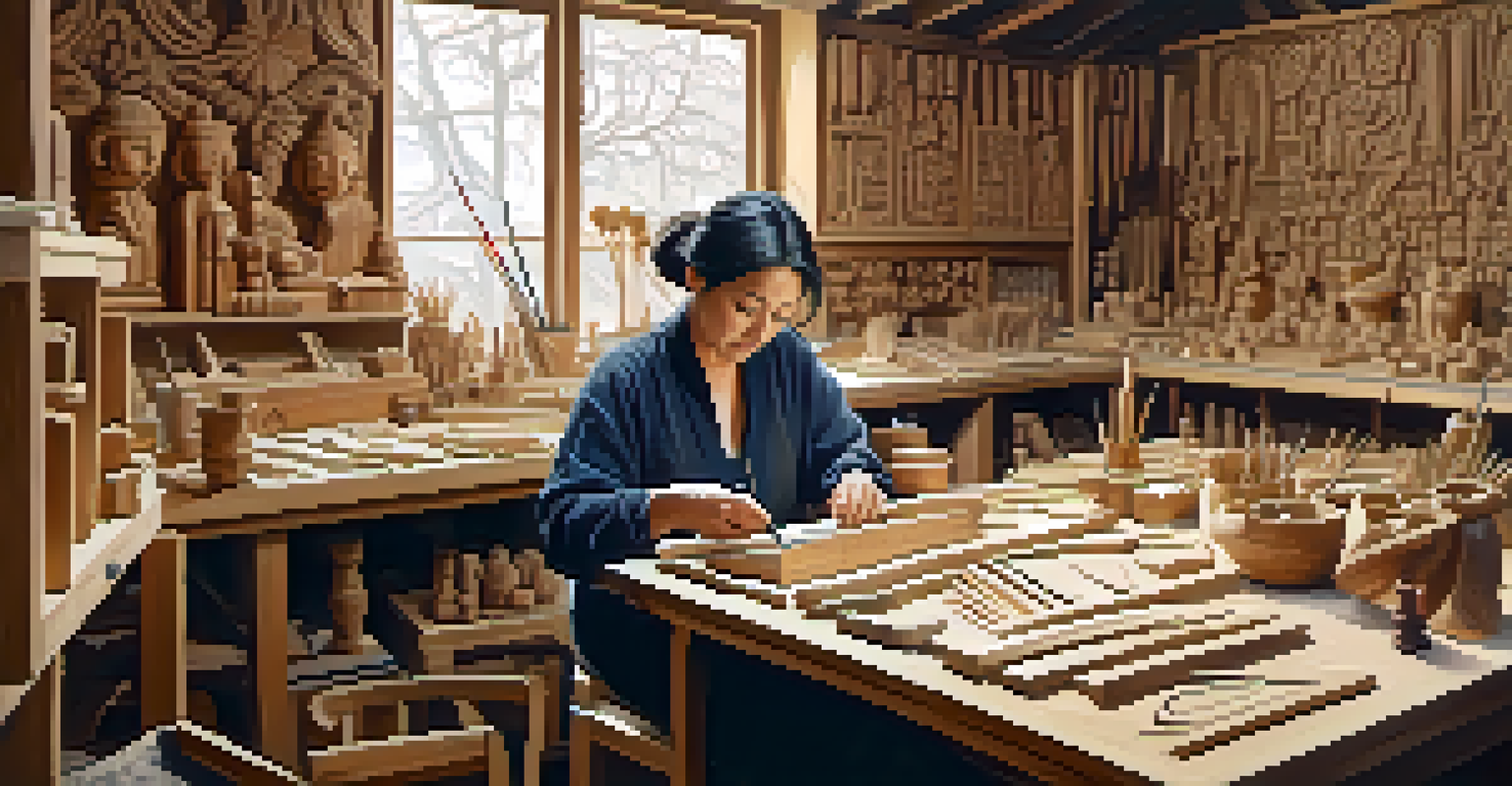The Influence of Regional Styles on Religious Carving Art

Understanding Religious Carving Art and Its Significance
Religious carving art is a unique form of expression that reflects the beliefs and values of a culture. From intricate wooden sculptures to stone reliefs, these artworks often serve as focal points in religious practices. They not only beautify sacred spaces but also tell stories of faith and spirituality.
Art is the most beautiful of all lies.
The significance of religious carvings can be seen in various cultures, where they symbolize devotion and convey spiritual messages. For example, in many Christian churches, carvings depict biblical scenes that educate and inspire worshippers. Similarly, in Hindu temples, sculptures of deities invite devotees to connect with the divine.
As we explore the influence of regional styles on these carvings, it's essential to recognize how geography, history, and local traditions shape the artistic expressions of different faiths.
Regional Styles: A Lens on Cultural Identity
Regional styles in religious carving art often serve as reflections of cultural identity. Each area boasts unique materials, techniques, and motifs that highlight local traditions and beliefs. For instance, the use of jade in Chinese religious carvings symbolizes purity and is deeply rooted in the region's cultural heritage.

In contrast, African religious carvings frequently utilize wood, reflecting the natural resources readily available in the environment. These carvings may depict ancestral spirits or important cultural symbols, emphasizing the community's connection to its past and beliefs.
Religious Carvings Reflect Beliefs
Religious carvings serve as vital expressions of faith, intertwining cultural identity and spiritual messages across various traditions.
By examining these regional styles, we gain insight into how communities express their identity through art, making each piece a testament to their shared history.
The Role of Materials in Shaping Carving Styles
The choice of materials plays a pivotal role in the style and execution of religious carvings. For example, the soft texture of wood allows for intricate detailing, which is often seen in European Gothic carvings. Artists can easily manipulate wood to create lifelike expressions and elaborate scenes.
Every human is an artist. The dream of your life is to make beautiful art.
Conversely, harder materials like stone or metal require different techniques and tools, resulting in a more robust and less detailed aesthetic. This is evident in many ancient Egyptian carvings, where stone was commonly used to create enduring representations of their gods and pharaohs.
The material not only influences the visual outcome but also affects the cultural significance of the carving, as different materials carry unique meanings across regions.
Historical Context: Influences of Time and Tradition
The historical context surrounding a region significantly impacts its religious carving art. Many styles have evolved over centuries, often blending various cultural influences. For example, the Baroque style in religious carvings emerged in Europe during the 17th century, characterized by dramatic detail and grandeur, influenced by the Counter-Reformation.
Moreover, as societies interact through trade, colonization, or migration, artistic styles may merge, creating hybrid forms. This is evident in Latin American religious carvings, where indigenous styles fused with European techniques, resulting in unique expressions of faith.
Materials Shape Artistic Expressions
The choice of materials in religious carvings influences both the artistic style and cultural significance, as different resources carry unique meanings.
Understanding this historical interplay helps us appreciate the rich tapestry of influences that define religious carving art today.
Symbolism in Regional Religious Carvings
Symbolism is a critical element in religious carving art, with each region imbuing its works with specific meanings. For instance, in Indian carvings, the lotus flower symbolizes purity and enlightenment, often used in depictions of deities. This reflects the spiritual beliefs central to Hinduism.
In Native American carving traditions, animals often carry significant spiritual meanings, representing various virtues and teachings. This use of symbolism connects the carvings to the community's worldview and values.
By exploring these symbols, we can uncover deeper layers of meaning in religious carvings and understand how they resonate with the beliefs of different cultures.
Modern Influences on Traditional Religious Carving
In today's globalized world, traditional religious carving art faces new influences that can reshape its practice. Modern artists often blend traditional techniques with contemporary styles, resulting in innovative interpretations of religious themes. This fusion can attract a younger audience and keep the art form relevant.
Additionally, the advent of technology has introduced new materials and methods, allowing artists to experiment beyond traditional boundaries. For example, some contemporary carvers may use 3D printing to create intricate designs that would be challenging to achieve by hand.
Preserving Artistic Heritage Matters
Efforts to preserve regional styles in religious carving art are crucial for maintaining cultural heritage and ensuring future generations appreciate these traditions.
While these modern influences may alter the appearance of religious carvings, they also provide opportunities for dialogue between tradition and innovation, enriching the art form.
Preservation of Regional Styles in Religious Carving
Preserving regional styles in religious carving art is essential for maintaining cultural heritage. Many communities actively work to keep these traditions alive through workshops, schools, and cultural events that teach younger generations about their artistic legacy. This transmission of knowledge is crucial to ensuring that these styles do not fade away.
Additionally, museums and cultural institutions play a vital role in preserving and showcasing these artworks, providing a platform for education and appreciation. They help raise awareness about the significance of regional styles and the stories behind them.

As we value and support these preservation efforts, we contribute to the ongoing narrative of religious carving art, ensuring that future generations can enjoy and learn from these beautiful expressions of faith.